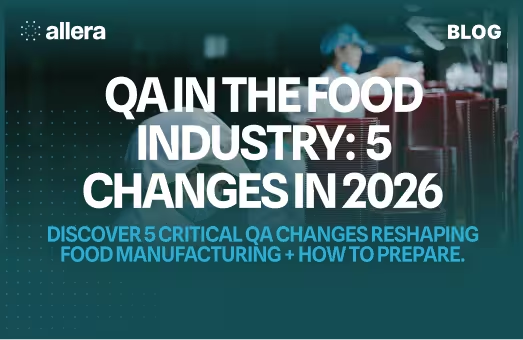

How to Create A Food Safety Plan in 2025

With the Food Safety Modernization Act (FSMA) 204 changes transforming how food manufacturers approach safety protocols, understanding food safety plans has become essential for compliance and operational success.
But what exactly is a food safety plan? And how do you create one?
No need to worry, whether you're developing your first food safety plan template or upgrading existing processes, this comprehensive guide will walk you through everything you need to know about creating, implementing, and maintaining effective food safety plans that meet FSMA requirements.
What is a Food Safety Plan?
A food safety plan is a comprehensive document that outlines systematic procedures to identify, prevent, and control food safety hazards throughout your manufacturing process. Unlike traditional reactive approaches, modern food safety plans take a preventive stance, addressing potential risks before they can impact product safety or consumer health.
The FDA Food Safety Plan Builder defines it as a tool designed to assist owners/operators of food facilities with the development of food safety plans that are specific to their facilities and meet the requirements of the Current Good Manufacturing Practice, Hazard Analysis, and Risk-Based Preventive Controls for Human Food regulation.
These plans serve as your roadmap for maintaining consistent food safety standards while ensuring regulatory compliance across all aspects of your operation—from ingredient sourcing to final product distribution.
FSMA Food Safety Plan Requirements
The Food Safety Modernization Act has revolutionized food safety regulations by mandating comprehensive preventive controls for most FDA-regulated facilities. FSMA protects public safety by requiring risk-based preventive controls and training appropriate to employees’ assigned duties.
Core FSMA Requirements
Every FSMA-compliant food safety plan must include several key components:
Hazard Analysis: You must conduct a thorough evaluation of biological, chemical, physical, and radiological hazards that could reasonably occur in your facility. According to FSMA requirements, manufacturers must also consider radiological hazards and economically motivated adulteration, expanding beyond traditional HACCP scope.
Preventive Controls: Based on your hazard analysis, you'll need to establish risk-based preventive controls including process controls, allergen controls, sanitation controls, and supply chain controls.
Monitoring Procedures: Written procedures for conducting checks at each preventive control step to assure the parameters or limits established for reducing, minimizing, or eliminating a significant hazard have been achieved.
Corrective Actions: Documented procedures for addressing deviations from established preventive controls, including immediate corrections and root cause analysis.
Verification Activities: Systems to ensure your preventive controls are working effectively, including validation of control measures and ongoing verification procedures.
Recordkeeping: Comprehensive documentation of all food safety plan activities, maintaining records that demonstrate ongoing compliance. Modern digital documentation solutions can significantly streamline this process while ensuring audit readiness.
Who Needs an FSMA Food Safety Plan?
All food sectors required to register with the FDA—except exempt sectors such as alcoholic beverages and dietary supplements, are mandated by regulatory agencies to comply with Preventive Control for Human Food regulations.
This includes food manufacturers, processors, packers, and holders that distribute products across state lines. Small businesses may qualify for certain exemptions, but most commercial food operations fall under FSMA requirements.
Food Safety Plan vs HACCP Plan: Understanding the Differences
Many food manufacturers wonder about the relationship between food safety plans and HACCP programs. While both systems focus on preventing food safety hazards, there are important distinctions.
Scope and Coverage
A Food Safety Plan, under the Preventive Controls for Human Food Rule of FSMA, builds upon HACCP principles by expanding hazard coverage and preventive control requirements. HACCP traditionally focuses on critical control points (CCPs) for biological, chemical, and physical hazards.
Food safety plans take a broader approach, incorporating:
- Expanded hazard types: Including radiological and economically motivated adulteration
- Multiple control types: Process, allergen, sanitation, and supply chain preventive controls
- Enhanced flexibility: As FSPs deal with preventive controls, there are no mandatory limits; however, they lean more toward minimum and maximum levels and/or ranges
Implementation Requirements
Food safety plans must be written, implemented, and overseen by a Preventive Controls Qualified Individual (PCQI), ensuring proper expertise guides your program development and maintenance.
Essential Components of a Food Safety Plan
Creating an effective food safety plan requires careful attention to each component. Here's what your plan must include:
Facility Information and Management
Your plan should begin with comprehensive facility details, including location, products manufactured, and management structure. This section establishes the foundation for all subsequent safety protocols.
Hazard Analysis
The hazard analysis forms the cornerstone of your food safety plan. Identify all potential hazards (biological, chemical, physical, and radiological) and assess their likelihood and impact.
Biological hazards might include pathogenic bacteria, viruses, or parasites that could contaminate your products. The CDC estimates that foodborne diseases affect 48 million Americans annually, highlighting the critical importance of biological hazard control. Chemical hazards encompass cleaning chemicals, allergens, and potential adulteration. Physical hazards include foreign objects like metal, glass, or plastic that could enter the food stream.
Process Flow and Preventive Controls
Develop detailed process flow diagrams that map every step of your operation. Create a flow diagram of all the manufacturing processes associated with your product. Once the diagram is created, you and your team should walk through the production area in the order of the manufacturing process to ensure that everything is accurate.
For each identified hazard, establish appropriate preventive controls with specific parameters, monitoring procedures, and responsible personnel.
Supply Chain Program
FSMA requires comprehensive supply chain management. Identifying your supply chain is another requirement of FSMA food safety plans, as that is where the risk of contamination and bacteria begins.
Your supply chain program should include supplier verification activities, approved supplier lists, and procedures for managing supplier non-conformances. Companies using automated supplier management can significantly reduce the administrative burden while improving supplier compliance tracking.
Recall Plan
A facility must develop a recall plan if it identifies a hazard requiring a preventive control. Your recall plan should enable rapid product traceability and removal from the marketplace when necessary.
Food Safety Plan Templates and Examples
While there's no standardized format mandated by FDA, using established templates can streamline your development process. While there is no standardized format mandated for a Food Safety Plan, the information should be arranged clearly and logically to show the hazard analysis process.
Available Template Resources
The FDA Food Safety Plan Builder provides an excellent starting point for facilities developing their first plan. Additionally, industry associations like the Food Safety Preventive Controls Alliance (FSPCA) offer standardized templates that are widely recognized by inspectors and auditors.
Customizing Templates for Your Operation
While templates provide structure, your food safety plan must reflect your specific operations, products, and facility layout. Consider factors like:
- Unique processing steps in your operation
- Specific allergens present in your facility
- Local regulatory requirements
- Customer specifications and requirements
Implementation Best Practices
Successfully implementing a food safety plan requires more than just documentation—it demands organizational commitment and systematic execution.
Building Your Food Safety Team
Form a team with members from different departments, ideally led by a PCQI. Your team should include representatives from production, quality assurance, maintenance, and management to ensure comprehensive coverage of all operational aspects.
Training and Education
Effective implementation depends on thorough training. Firm management must ensure proper education and training for employees that manufacture, process, pack, or hold food. This training should include food and employee hygiene and safety.
Consider both initial training for new employees and ongoing education to keep staff current with evolving best practices and regulatory requirements.
Since PCQI's are at the center of your plan it is vital that they are trained well. To help you with this, we made a list of the 7 best PCQI training programs in 2025-2026.
Continuous Improvement
Food safety plans aren't static documents. Regular review and updating ensure your plan remains effective and compliant. Regularly evaluate and update your digital quality assurance processes to keep up with industry advancements and changing regulations.
Schedule periodic reviews to assess plan effectiveness, incorporate lessons learned, and adapt to operational changes.
Common Food Safety Plan Challenges and Solutions
Implementing food safety plans often presents challenges that can be addressed with proper planning and the right tools.
Documentation
Many facilities struggle with the extensive documentation requirements under FSMA. Digital solutions can significantly reduce this burden by automating record-keeping and ensuring consistent, accurate documentation. Learn more about going fully digital and how it transforms food safety operations.
Resource Constraints
Smaller facilities may lack dedicated food safety personnel. Consider outsourcing PCQI functions or investing in user-friendly digital platforms that simplify compliance management. Solutions like food safety software platforms can help smaller teams manage complex requirements more effectively.
Keeping Up with Regulations
Regulatory requirements continue to evolve. Choose solutions that offer automatic updates and maintain connections with industry experts who can guide compliance efforts. Explore how comprehensive food safety platforms help companies stay ahead of regulatory changes.
The Future of Food Safety Planning
The food safety landscape continues to evolve, driven by technological advancement, changing consumer expectations, and emerging global challenges.
Emerging Technologies
Artificial intelligence and machine learning are beginning to play larger roles in food safety, offering predictive analytics that can identify potential issues before they occur. AI-powered decision support can enhance quality assurance processes by predicting potential issues and automatically flagging them for review and intervention.
Increased Automation
Automation extends beyond documentation to include real-time monitoring systems, automated corrective actions, and integrated supply chain management. These advances promise to make food safety management more efficient and effective.
Enhanced Traceability
FSMA Section 204 now establishes additional recordkeeping requirements for certain foods and outlines a list of items on the Food Traceability List that require enhanced traceability recordkeeping due to their high-risk nature. The FDA’s food traceability requirements emphasize the critical role of traceability in protecting the food supply chain.
This trend toward enhanced traceability will continue, requiring more sophisticated tracking systems and greater supply chain transparency.
Take Action: Modernizing Your Food Safety Plan
Creating and maintaining an effective food safety plan is crucial for regulatory compliance, operational efficiency, and consumer protection. Whether you're developing your first plan or updating existing procedures, the key is to choose an approach that fits your operational needs and growth trajectory. Learn more about digital food safety transformation and how it's revolutionizing the industry.
As Caitlin Edsall from Eden Green emphasizes: "I highly recommend Allera to any organization wanting to streamline operations and boost efficiency. The platform is user-friendly, customizable, and integrates seamlessly without extra tools. With Allera, we digitized every form, implemented rules to prevent missed actions, and saved time on record management."
The investment in comprehensive food safety planning—whether through traditional methods or modern digital platforms—pays dividends in reduced risk, improved efficiency, and enhanced compliance. Consider evaluating digital solutions that can streamline your food safety management while ensuring you meet all FSMA requirements.
Remember, food safety planning is not just about compliance—it's about building a sustainable foundation for your business success while protecting the consumers who trust your products.
FAQs
What are the simple food safety policies?
Simple food safety policies include handwashing before food handling, using gloves when appropriate, keeping hot foods hot and cold foods cold, cleaning equipment regularly, and rejecting deliveries that show signs of spoilage or contamination.
What are the 5 basic food safety rules?
The 5 basic food safety rules are: Wash hands and surfaces often. Keep raw and cooked foods separate. Cook foods to safe temperatures. Store food at safe cold or hot holding temperatures. Use safe water and raw materials.
What is an example of a food safety policy?
An example of a food safety policy is: “Our facility is committed to producing safe food by following HACCP principles, maintaining strict hygiene practices, training all employees on food safety procedures, and continuously monitoring and verifying compliance with regulatory standards.”
What are some examples of food safety?
Examples of food safety practices include washing hands before handling food, keeping raw meat separate from ready-to-eat foods, cooking chicken to 165°F (74°C), refrigerating leftovers promptly, and labeling allergenic ingredients clearly.
What does a food safety plan consist of?
A food safety plan consists of hazard analysis, identified preventive controls, monitoring procedures, corrective actions, verification activities, and required documentation. It also includes prerequisite programs like sanitation, pest control, and employee hygiene practices.
What are the 4 basic rules of food safety?
The 4 basic rules of food safety are: Clean – wash hands, surfaces, and produce. Separate – avoid cross-contamination between raw and cooked foods. Cook – heat food to safe internal temperatures. Chill – refrigerate promptly and keep cold foods at 41°F (5°C) or below.
What are the three types of food safety plans?
The three main types of food safety plans are: HACCP plans – focused on hazard analysis and control points, Preventive controls plans (FSMA) – broader, covering all preventive measures, Prerequisite programs (PRPs) – foundational hygiene and sanitation programs that support HACCP and FSMA compliance.
What are the components of a food safety plan?
The main components of a food safety plan include: hazard analysis, preventive controls (process, allergen, sanitation, and supply-chain controls), monitoring procedures, corrective actions, verification activities, and comprehensive recordkeeping.
How do you write a food safety plan?
To write a food safety plan, begin with a hazard analysis of your production process, then outline preventive controls for biological, chemical, physical, and allergen risks. Define monitoring procedures, corrective actions, verification steps, and maintain detailed records. Most plans are built using HACCP principles combined with regulatory requirements like FSMA.
What are the 3 C's of food safety?
The 3 C’s of food safety are Cleaning, Cooking, and Chilling. These steps prevent contamination, kill harmful bacteria, and keep food out of the danger zone where bacteria multiply.
What is the HACCP food safety plan?
A HACCP food safety plan is a structured system that identifies and controls potential hazards in food production. It focuses on preventive measures rather than end-product testing, ensuring food safety at every step of the process by managing critical control points.
What are the 7 stages of writing a food safety management plan?
The 7 stages of writing a food safety management plan typically follow the HACCP framework: Assemble your food safety team, Describe your product and intended use, Map the process flow, Conduct a hazard analysis, Identify critical control points (CCPs), Establish monitoring, corrective actions, and verification procedures, Document everything in a structured plan with record-keeping systems.
What role does technology play in improving a food safety plan?
Digital systems can automate monitoring, streamline documentation, enhance traceability, and provide real-time alerts to prevent safety issues before they escalate.
Does the FDA require a HACCP plan or a food safety plan?
Not all facilities need HACCP plans, but most FDA-regulated facilities must have a written food safety plan that meets FSMA’s preventive controls requirements, which incorporate HACCP principles.
What is a Preventive Controls Qualified Individual (PCQI) and why is one required?
A PCQI is trained or experienced in preventive controls and is responsible for developing, implementing, and maintaining the food safety plan to meet FSMA standards.
Do separate facilities need their own food safety plans?
Yes. Even if they produce the same product, each facility must have its own plan because layouts, equipment, and hazards vary.
How often must a food safety plan be reanalyzed?
Under FSMA, each facility must reanalyze its food safety plan at least once every three years, or sooner if there’s a significant change in processes, equipment, or hazard controls.




.avif)


.avif)
.avif)

